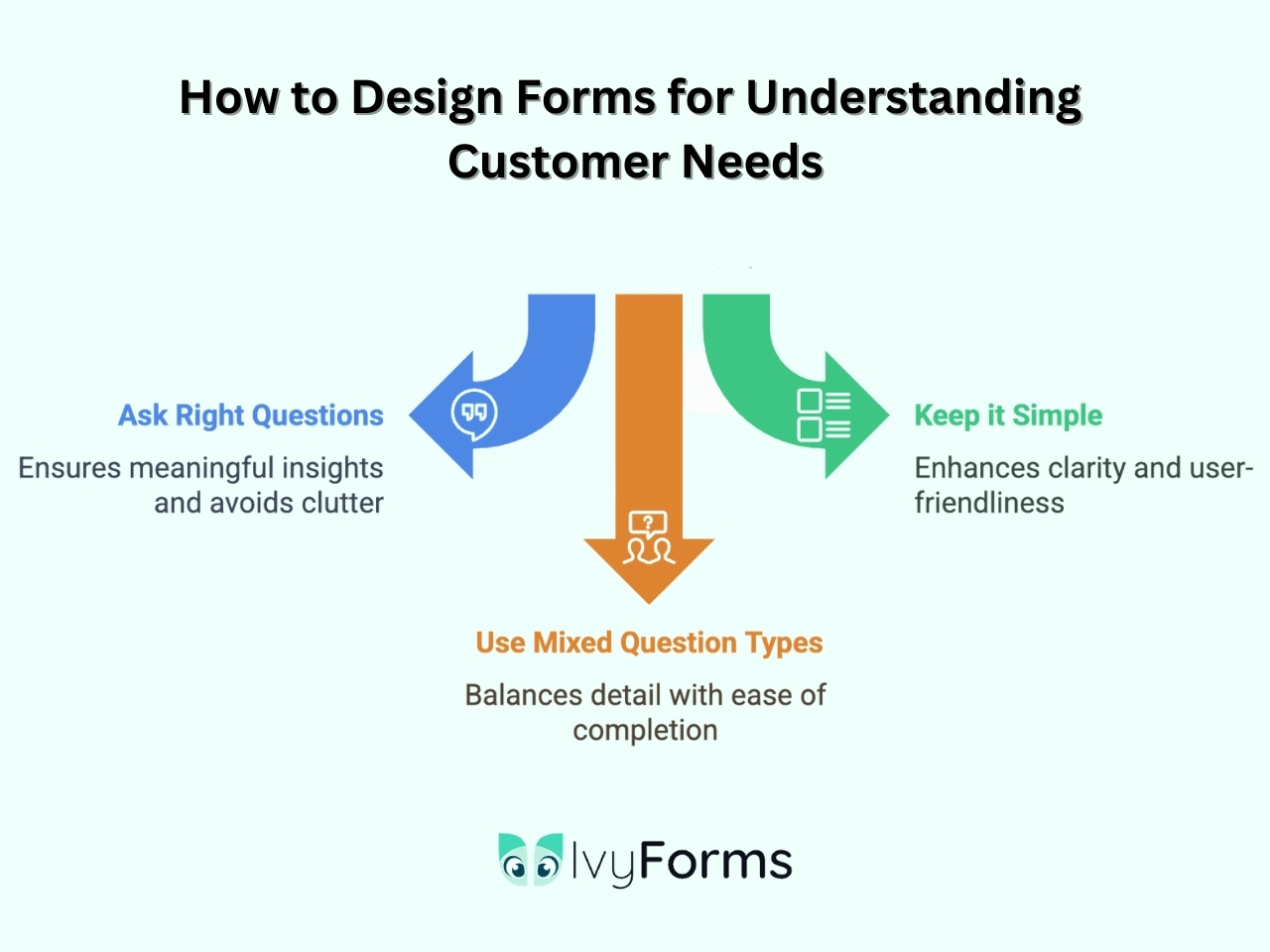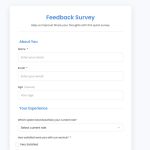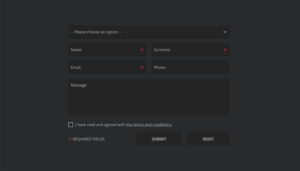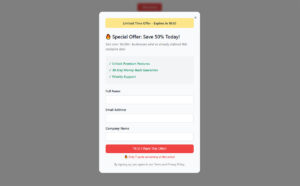Your website visitors want to reach you. Without a form, they can’t. Understanding what WordPress forms are and why they matter changes how you approach visitor communication, lead capture, and…
Table of Contents
Understanding your customers’ needs is like having the ultimate cheat code for business success. When you know exactly what they’re after, you can tailor your products, services, and marketing strategies to hit the mark every time.
The problem? Sometimes, knowing how to understand your customer’s needs can feel like finding a needle in a haystack. But here’s the good news: it doesn’t have to be so hard.
Believe it or not, the answer lies in forms. In fact, when used correctly, forms are like a goldmine for customer insights. So, if you need any help navigating the complex world of clients’ wishes, keep on reading.
Why is it Important to Understand Customer Needs?
Imagine trying to sell a winter coat in the middle of a heatwave. Not only is it a tough sell, but it’s also a sign you’re a bit out of touch with what your customers actually want. Understanding customer needs is like having a map to navigate even through roads you’ve never been on.
When you know what your customers are looking for, you’re not just guessing what’ll stick; you’re hitting them right where it counts. It’s not just about knowing if they like your product. It’s about understanding their expectations and frustrations, too. Are they happy with what you’re offering? What could you do better?
By understanding customer needs, you can tailor your products, services, and marketing strategies to match what people want. But here’s a hard pill to swallow: it’s not always obvious. Customers don’t always spell out exactly what they need. Sometimes, you need a little help, and that’s where forms come into the picture.
How to Understand Customer’s Needs
Alright, so by now, we know understanding your customers’ needs is crucial, but how do you actually figure out what those needs are? To truly understand your customers, you need real, honest feedback.
You can’t just assume you know what your customers want based on trends or past experiences. Things change, and your customers’ needs evolve, too. So, how do you stay ahead of the game?
The answer is pretty simple – you listen. And while you can’t call every customer on the phone and ask them everything you might want, there is a perfect solution for this – forms! Forms are a powerful tool for gathering insights without the hassle. They allow you to ask the right question and eliminate any guesswork with actionable feedback.
Types of Forms That Help You Understand Your Customer’s Needs
With such a wide variety of forms, you must know that different types give you different insights. That’s why choosing the right one is key.
Want to know what your customers really think? Here’s a breakdown of the best forms to get you the answers you need.
Customer feedback forms
These are the forms you’re likely seeing everywhere. When you buy something or get a service done, there’s usually a pop-up or an email asking you to rate your experience. After you give your star rating, there is usually a small box where you can share your thoughts as well. And there is a good reason you are seeing these forms all over the place – it’s because they work!
Customer feedback forms are the gold standard for gathering quick, actionable insights from your customers. They help you understand what’s working well and where you might need to improve. Maybe they loved the product, but felt your delivery could have been faster. Or perhaps they thought your customer service was on point, but your website was impossible to navigate.
The beauty of feedback forms is that they give customers a chance to speak up in their own words. Plus, they’re super easy to set up. The key is to keep them simple so filling them out doesn’t seem like a chore but more like an opportunity to share.
Surveys
Surveys take feedback to the next level. Think of them as the detailed version of feedback forms that allow you to ask more specific questions and gather broader insights.

Surveys are perfect when you want to learn more about your customers’ preferences, satisfaction levels, or even potential new products or services they’d be interested in. Whether it’s a multiple-choice question or an open-ended prompt, surveys can help you understand trends across your customer base.
You can look at responses as a whole, spot patterns, and make data-driven decisions that will guide your business strategy. Want to know which features your customers care about most? Or what areas need improvement? A well-designed survey can tell you exactly that.
Contact forms
Contact forms might seem simple, but don’t underestimate their power. These little forms are a goldmine for learning about your customers’ needs in real time. Because when people reach out to you, they are likely looking for something specific, and this is how you can get the best insights.
With contact forms, you can capture immediate needs, ultimately staying on top of customer expectations. They are easy to implement, and customers have no issues filling them out as they usually have just a few questions.
Client intake forms
If you run a service-based business, client intake forms are a must-have. These forms are your first chance to really get to know your clients before you even start working with them. It’s like having the first introductory meeting, but everything is outlined for you on a piece of paper.
Whether it’s a project brief, their budget, or any specific challenges they’re facing, these forms help you understand exactly what you’re working with. The better you understand your clients upfront, the better you can tailor your services to fit their expectations.
And unlike the in-person meeting, with these forms, you’ll never have an issue with important information slipping through the cracks. Plus, it sets a professional tone, showing that you’re organized and serious about delivering exactly what they need.
Registration or subscription forms
You might not immediately think of registration or subscription forms as a tool for understanding customer needs, but we assure you that they can be. When customers sign up for your newsletter, create an account, or subscribe to your service, you’re gathering more than just an email address or contact info. You’re learning about their interests, preferences, and what kind of content or service they’re looking for.
For example, let’s say a customer subscribes to a product-related newsletter or registers for an event. The kind of information they provide can help you refine your offerings and tailor your marketing.
These forms also serve as an entry point to deeper customer engagement. The more data you collect upfront, the better you can personalize your communication, making customers feel valued and understood.
How to Effectively Design Forms for Understanding Customer Needs
Once you know which type of form you want to utilize, the next challenge is designing it to actually help you gain the insights you need. After all, a poorly designed form is like a dead-end street – it won’t get you anywhere.
To help you get the most out of your forms, here are some tips to keep in mind.

Ask the right questions
For both form completion rates and design purposes, make sure you ask the right questions. The goal isn’t to overwhelm your customers with a never-ending list of queries, but to ask thoughtful, purposeful questions that will provide meaningful answers.
Frankly, no one wants to fill out a form that looks cluttered and impossible to navigate. So, be sure to outline everything you want to know from your customers first, and then think about the form structure. Make sure it’s visually appealing with enough white space in between. Lastly, ensure questions follow a logical flow and that there is a visual hierarchy.
Keep it simple and user-friendly
When creating a form, a simple principle you should always follow is that clarity is key. Your form isn’t a test you want your customers to fail, but a helpful tool for understanding their needs.
Keep the questions clear and straightforward, and avoid jargon or complicated language. The simpler and more intuitive the form, the more likely people are to fill it out completely. Think of it this way: If your form feels like a breeze to fill out, your customers will be happy to share their thoughts. But if it feels like a maze, they’ll bounce before finishing.
Use the mix of question types
While it’s great to leave enough space for your customers to say everything they want, only focusing on open-ended questions can make people less likely to finish the form. The reason? Open-ended questions require more thought and effort, and people might get overwhelmed or lose interest.
That’s why it’s important to mix in a variety of question types. Use multiple-choice or rating-scale questions for quick responses, and sprinkle in a few open-ended questions for more detailed feedback. This balance keeps things easy to complete while still allowing your customers to express themselves fully.
Best Practices to Understand Customer Needs and Expectations Through Forms
Alright, so now that you have your forms and your strategy, let’s talk about how to really make them work for you. If you want to get real, actionable insights from your customers, you need to know how to use those forms in the best way possible.
Timing and placement
Even the best-designed form won’t do much for you if you place it poorly or time it wrongly. Imagine filling up your shopping cart, getting ready to check out, and suddenly being hit with a huge survey asking for detailed feedback. It’s not the right moment, right? Timing is everything.
The key is to find the sweet spot. Display forms at moments when customers are most likely to give you thoughtful feedback. This is usually right after they make a purchase or use your service.
Placement also matters. You can’t put a feedback form in the footer of your website and expect someone to spot it. Make sure the form is easy to find and pops up at the right time. This will ensure you get the most submissions.
Follow-up and engagement
So, you’ve got the feedback – now it’s time to make it count! Don’t just let those responses sit there. Reach out and engage with your customers. A quick thank-you goes a long way, but it’s even better if you can show them how their feedback is shaping your business.
Remember, this is also a great chance to build a stronger relationship. Offering a special deal or sharing an exciting update can make customers feel appreciated and more connected to your brand. Keep the conversation going, and you’ll have customers who feel heard and valued.
Conclusion
To truly understand your customers’ needs, you need more than just assumptions – you need real, actionable feedback. Forms are a simple yet powerful way to collect this feedback and make informed decisions about your products, services, customer experience, and marketing efforts.
So, don’t leave it to chance – take the time to listen to your customers, understand what they want, and let that drive your success.





